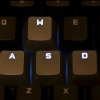More bits, more numbers. So where is more than 64 bit computation?
Nothing is stopping you from doing this, other than maybe convenience. You can allocate any arbitrary number of bits and treat them as a number, but you'll have to take care of e.g. carry over if you add two such numbers, since the CPU has no native support for it. Even just basic addition, subtraction, multiplication and division will take take time to implement.
Of course ideally you'll want to use a library (or write your own) that takes care of this under the hood. For example in Java you have classes like BigInteger, which can theoretically represent integers of (almost) arbitrary length.
Internally it uses an int[] to be able to use more than 32 bit, so technically you're limited by the maximum size of an array (limited by the JVM and available memory). So the maximum number it can represent is as high as 2(32 x 2,147,483,642). Just keep in mind that one such number on its own would already require roughly 8 GiB of memory.
Realistically, you'll find few use cases (other than maybe scientific) where 232 or 264 isn't big enough for your needs.

.thumb.jpg.ab6821c090888206ddcf98bb04736c47.jpg)















Create an account or sign in to comment
You need to be a member in order to leave a comment
Create an account
Sign up for a new account in our community. It's easy!
Register a new accountSign in
Already have an account? Sign in here.
Sign In Now